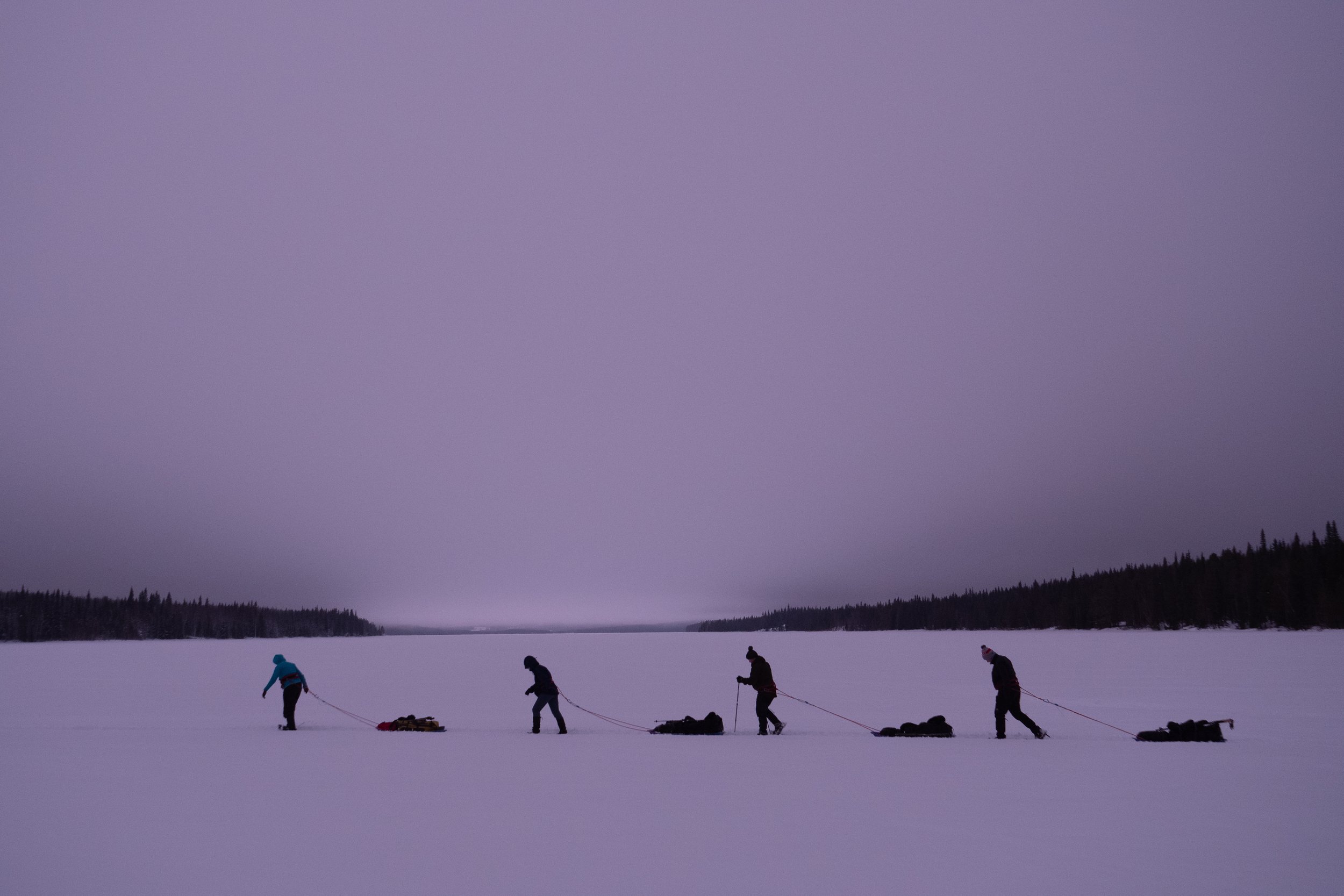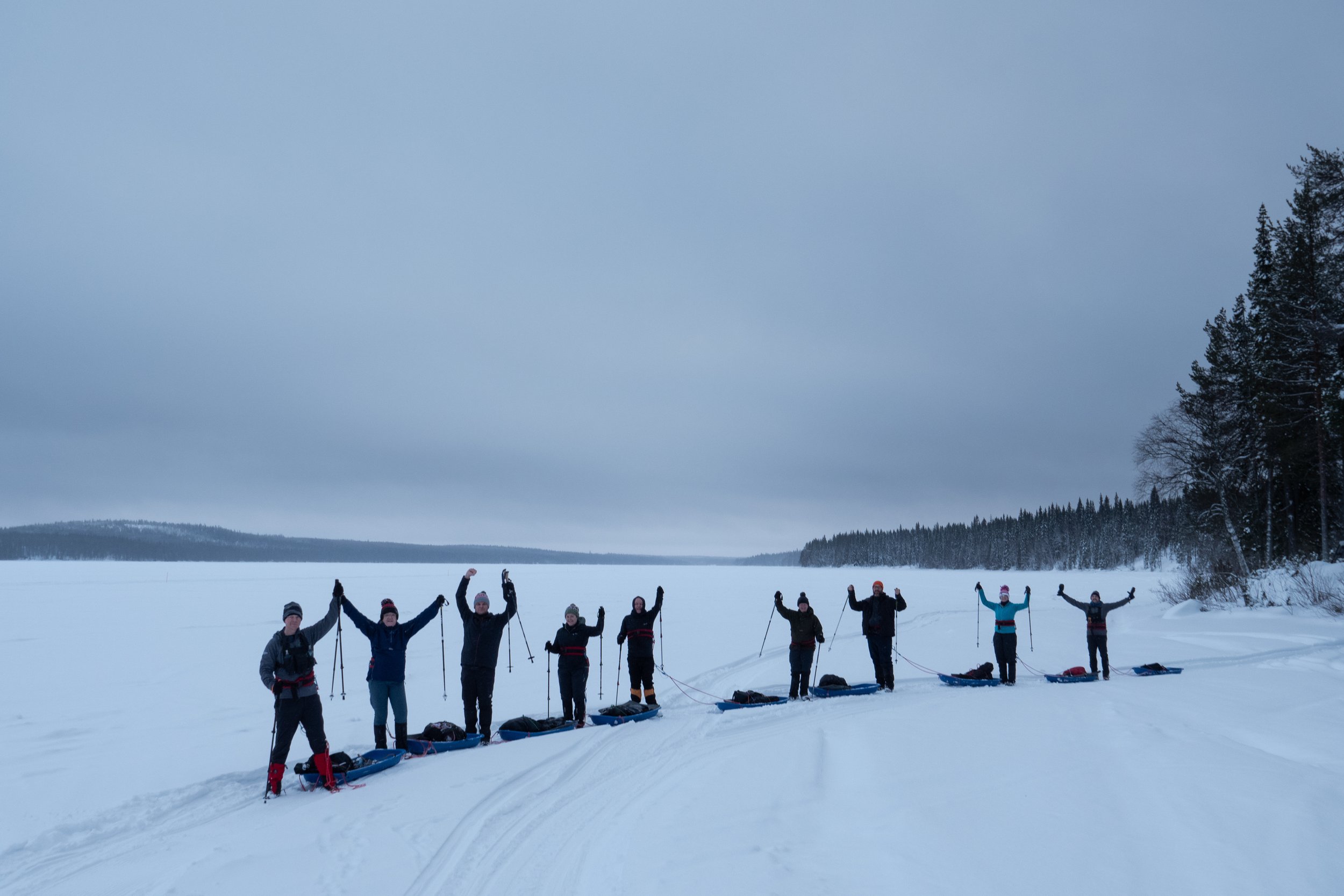Michael Gregson’s - Arctic Trek
Michael Gregson had first joined his Blackford colleagues by spending the day lending a hand at the Ripple Retreat over a year ago. He came away deeply affected by the experience and decided he wanted to do something else to help. After hearing about the Arctic Trek challenge he signed up immediately.
So on Wednesday, February 5th, after more than a year of planning (a lot), training (a bit), and talking about the challenge which lay ahead (so much), Michael boarded a flight to Helsinki to head for Rovaniemi in the Arctic Circle – which also happens to be Santa’s home village. We’ll let Michael pick up the story from here:
Day one: new friends and lots of snow
The day has finally arrived. After a disgustingly early alarm, I got to Edinburgh airport at 4.30am for the 6.30am flight – the first of three that would eventually get me to Rovaniemi, which lies right on the Arctic Circle. I met a few fellow travellers at Edinburgh and, bags checked, we sat down together for breakfast. It felt like a bond was established immediately. As it turned out, this bond would be one of the highlights of the entire trip.
When we landed in Rovaniemi we took the first of many pictures of snow. To be fair, it was the kind of snow that would bring UK airports to a standstill for days. In Finland, though, they’ve clearly learned to adapt.
In our hotel that evening, we continued the camaraderie – sharing our stories of why we had signed up for the trek, our anxieties about the challenge ahead, as well as a few beers and (with apologies to Santa) some reindeer stew. It felt like a reunion of old friends rather than a group of strangers meeting for the first time.
Day two: safety briefing and pulk packing
The first proper indication of what we had got ourselves into was a safety briefing which took more than three hours to complete.
We’d each pull our kit behind us in a pulk – a sled – using a harness. This was our chance to learn how to get ourselves set up so we’d be comfortable (ish) over the course of hours of walking in the snow. It was also suggested to some of us that we may have packed a little too much and perhaps not everything we’d brought needed to go into our pulk.
Then we learned how to spot the early signs of hypothermia in our fellow trekkers, which was a pretty sobering prospect.
After packing, unpacking and repacking my gear about eight or nine times, blood pressure rising all the time, we had some lunch and headed to Santa Claus village. Some people decided to go and see the big man himself, while the rest of us had a stroll around and took the opportunity to take in our surroundings over a coffee.
That evening, despite the convivial surroundings of a local Italian restaurant, there was a palpable nervousness in the room. The next morning we’d set off into the unknown.
Day three: the trek begins
We met early in the hotel reception to set up our pulks and packs for a 9am start. I’d like to say at this point we were seasoned, calm adventurers, ready to take on the wild. Headless chickens might be a better description. Most, if not all, of us had put on kit in the wrong order, packed away items we’d need during the day, forgotten to tie our boot laces before putting on our gloves and so on. Nerves had got the better of us.
But soon we were underway, making our way onto a vast frozen river as the town gradually receded behind us. Apart from a cross-country skier who seemed to appear from nowhere, there wasn’t another soul to be seen.
Winding our way up into a forest, the snow felt soft underfoot and made for hard going. Our guides described the impact of climate change on this part of the world. Not all that long ago, trekkers could expect temperatures as low as -30 degrees Celsius. The coldest it got for us was -13. Now, that’s plenty cold enough for me, but it’s alarming evidence of what global warming is doing to the Arctic.
As we emerged from the forest to another spectacular view down towards a frozen lake, our guide Hanne told us we’d need to deviate slightly from the planned route to avoid potential overflow; a potentially dangerous phenomenon where water wells up underneath ice and spreads to the snow above. The resultant slush can trap people, animals and snowmobiles.
Past the area of concern, the temperature dropped noticeably as the light faded and the head torches had to come out. We walked single file on the exposed ice, in the dark, with no visual reference points other than the person in front. It’s hard to gauge time but my guess is we walked like this for at least two hours.
Eventually we saw a head torch in the distance which told us we were approaching our camp for the evening; pre-prepared by the event guides along with a warming fire. After an amazing hot meal, our tired spirits lifted and we settled down for what turned out to be a good night’s sleep.
Day four: breakfast by moonlight and gusty winds
One of the most memorable points for me was the morning of day four. With the sun still below the horizon, I emerged from my tent for some hot porridge. The pale Arctic moon illuminated the frozen lake below, and shone through the trees to give our campsite an eerie glow.
After breaking camp we headed down towards the lake, now in daylight. At our first break from the walk some of our group were starting to struggle with the cold and as the physical demands of the trek started to tell.
As the day continued and I spoke to others in the group, we discovered some mutual connections in Edinburgh – which by now already felt like a different world.
The route started to head uphill. With the light dimming, we put on head torches and gritted our teeth for another several kilometres in the dark. Suddenly we heard the noise of engines and a group of people appeared on snowmobiles. We don’t know who got more of a fright – us, at the noise, or them, at the sight of seven lunatics walking through the forest in the dark.
As the sound faded into the distance, we noticed the smell of burning wood. Then we saw a faint orange glow through the trees as our camp came into view. The wind had picked up so the prospect of a rest spurred us on.
We ate beside the fire, trying not to inhale the swirling smoke as the wind continued to blow. Tired, cold and uncomfortable, we retreated to our tents. The tents flapped and shook in the wind through the night, so sleep was broken and restless.
Day five: Husky hugs and the Finnish line
One of the group had shown signs of hypothermia the previous night and received brilliant help and support from the guide team. He woke up a different person on the final morning – I guess he had a good sleep, although I don’t know how he managed through the noise of the wind.
The start of day five brought incredible scenery. Our campsite occupied an elevated position above the treeline so we were treated to some awesome views as we descended from the hill.
In the distance we heard barking and howling. A sled drawn by a husky team appeared out of the forest.
As the sled driver – or musher, to use the correct term – passed our group, he brought the dogs around and stopped to chat. Talk about good timing. He let the dogs free of their reins and we spent the next 15 minutes with these beautiful, affectionate animals, which gave everyone’s mood a lift.
Back on our way again and we noticed more and more snowmobiles starting to pass – we were finally approaching civilisation. The member of our group who’d suffered from mild hypothermia the previous evening suddenly ran out of steam and couldn’t take another step. We stopped for a break to allow him to get onto a snowmobile for the final kilometre.
The rest of us walked the final stretch across a frozen lake and crossed the line as one team. We made it!
That night (after a welcome and very necessary shower) we relived our adventure over a meal and a few drinks in our hotel. I reflected on the motivation for this adventure and felt very grateful for the generosity of clients, friends and relatives, and the fact that I’d been fortunate enough to take part.
Together, we’ve raised an incredible £14,700 for It’s good 2 give. That money will allow several families coping with cancer treatment to visit the Ripple Retreat and spend some precious time together.
What a massive achievement and It’s good 2 give are truly grateful to Michael for taking on such an amazing trek. Also the challenge and dedication to raise such a fabulous amount for us.
Thank you Michael.




